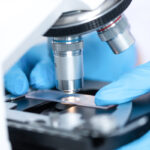What are the Diagnosis, Stages and Dimensions of Chocolate Cyst?

What are the Diagnosis, Stages and Dimensions of Chocolate Cyst?

The inner surface of the uterus thickens with each menstrual cycle, making it suitable for the placement of an embryo. When an egg released from the woman’s ovaries is not fertilized, the thickened inner layer of the uterus is expelled with bleeding after a certain period of time. When menstrual bleeding flows backwards in an unusual way during bleeding, some blood is carried into the abdominal cavity. In this case, the endometrium cells settle in any area on the line they are carried and start to behave like the inner layer of the uterus, that is, they thicken and shed with some blood every month. Such bleeding can accumulate over time, causing inflammatory reactions, adhesions or mass formation in the area where they are placed.
When endometrial cells settle in the ovaries, structures called chocolate cysts are formed, usually filled with a liquid that resembles melted chocolate in color and appearance. Chocolate cysts usually present with chronic pelvic pain at any time, or pain felt in deep areas during sexual intercourse, or severe pain during menstrual bleeding. These types of pain are too severe to be treated with painkillers.
Pains that occur in this way can be caused by different factors. Inflammatory reactions that occur due to bleeding from disease foci that occur when the inner layer of the uterus settles in an area outside can be the cause of pain. Severe menstrual pains that occur during menstrual periods and do not respond to treatment are caused by inflammatory reactions. These pains can occur when the wastes that occur due to bleeding from foci in chocolate cysts cause adhesion between surrounding organs and tissues. Pain felt during sexual intercourse and chronic pelvic pain are also caused by these adhesions.
Chocolate cysts may be the underlying factor for problems such as inability to conceive or infertility, and irregular menstrual periods. Adhesions formed by the residues left from bleeding may cause blockage in the tubes or deterioration in the functions of the tube hairs. Therefore, the egg released from the ovaries cannot pass to the fallopian tubes or cannot progress in the blocked tube. As a result, infertility develops in the woman.
Determination of Chocolate Cyst in Ovarian Cyst Surgery
If a woman has one or more of the symptoms, chocolate cysts are suspected. These can be easily observed with gynecological examination and ultrasound examination. In order to make a definitive diagnosis of cysts, a pathological examination of the cyst removed by surgery must be performed.
If the Ca-125 value is high during a blood test performed on the woman, this indicates the presence of a tumor. Although it is not necessary to measure this value, the decrease in the Ca-125 value at the end of the treatment is important to evaluate the success of this treatment and to prevent recurrence.
Because chocolate cysts are a progressive and insidious disorder, they can sometimes progress without any symptoms. Most women are diagnosed by chance during examinations.
What are the Stages and Sizes of Chocolate Cysts?
Chocolate cysts are formed when the endometrium, the inner layer of the uterus, migrates to an area outside the uterus and settles there. The cells that act like the inner layer of the uterus in the area where they settle can lead to the formation of various lesions in the uterus, ovaries and the inner parts of the abdomen. The stages and dimensions of the chocolate cyst are determined by taking into account the prevalence of the lesions that occur. Existing lesions whose nature cannot be fully determined are classified from the first to the fourth stage by their location, size and depth of invasion and by taking into account the nature of the adhesions in the fallopian tubes.
Stage 1 (Minimal endometriosis)
This stage is the beginning of the disease. Since chocolate cysts cannot be easily observed at this stage, diagnosis may be difficult. Patients have not yet started to have obvious complaints at this stage.
Stage 2 (Mild endometriosis)
At this stage, the disease has progressed a little more. However, in the first and second stages, the patient does not need to undergo surgery. However, if sexual intercourse or menstruation is painful, these cysts may need to be burned with the help of laparoscopy. Because the pain at this stage is bearable, early treatment of chocolate cysts is usually neglected.
Stage 3 (Medium endometriosis)
At this stage, chocolate cysts that have progressed a little more have become easily visible on ultrasound. The size of the cysts that have reached this stage can be approximately 3-4 cm. Patients begin to feel discomfort more clearly at this stage.
Stage 4 (Severe endometriosis)
Cysts that have reached this stage can be easily detected with vaginal ultrasound. In this stage, due to the ovaries sticking together, cysts may be attached to the last part of the intestine, in the middle, and in some cases to the back of the uterine wall. This is the last stage where chocolate cysts complete their formation. Women experience the most problems in this stage. Pain is felt at an advanced level in this stage. In this stage, lesions can be divided into black, red and white according to their color.
The stages and dimensions of chocolate cysts are determined by detecting the typical appearance of these cysts with transvaginal ultrasound. However, a definitive diagnosis is made by pathological examination of the cyst after surgery.
Is Chocolate Cyst a Genetic Disease?
In one study on this subject, it was determined that sisters were 6 times more likely to have chocolate cysts than their husbands’ sisters, and in another, it was 8 times more likely than other women. Genetically affected sisters may have a more severe condition than others. However, there is no definitive information on how effective such a genetic transition is.
How Common Is Chocolate Cyst?
Chocolate cysts are seen in 2-5% of the general population and in 30-40% of women who have not had children before.
What are the causes of chocolate cysts?
Various theories have been put forward about the formation of chocolate cysts. These are;
- The endometrial tissue of the uterus passes through the tubes into the abdomen, causing chocolate cysts. However, there is no information about how these cysts form in women who have previously had their tubes tied or their uterus removed.
- It occurs when the tissues that are shed due to bleeding from the inner lining of the uterus each month in a normal cycle attach to and grow in any part of the body due to an abnormality in the immune system.
- Because they are seen so frequently in members of some families, these cysts are thought to be caused by a congenital disorder of genetic origin.
- It occurs when the tissue inside the abdomen changes to endometrial tissue due to recurrent inflammation.
- It is thought that cysts are formed when the inner layer of the uterus spreads from the uterus into the abdomen via blood and lymph flow.
How Do Chocolate Cysts Prevent You from Having Children?
- Chocolate cysts cause adhesions between organs, especially the uterus, ovaries, tubes and intestines.
- Causes blockages in the fallopian tubes
- It reduces the healthy tissue in the ovaries or negatively affects ovarian reserves.
- It disrupts follicle development in the ovaries and causes hormonal irregularities.
- It prevents healthy embryo development and prevents the embryo from attaching to the uterus.
- May cause changes in the immune system
Infertility is one of the most common complaints affecting women with chocolate cysts. These women cannot conceive without the necessary treatment. In order to treat infertility, the first ovulation induction and insemination method are applied. Patients who cannot conceive after these treatments should undergo in vitro fertilization treatment. Patients who have undergone laparoscopy or open surgery due to chocolate cysts are advised to conceive naturally for 1 year. In vitro fertilization should be applied to women who cannot conceive naturally during this period or who have other problems that prevent pregnancy during the surgery.
Infertility is seen in approximately 60-70% of chocolate cyst patients in the society. This rate is approximately 3-4 times higher than the general population. The monthly pregnancy rate of women with chocolate cysts decreases to 12-36%. It has been determined that the pregnancy rate of women does not increase with the treatment of chocolate cysts in the first stage. However, infertility is seen even in mild cases of cysts, that is, in the first two stages. In these patients, the risk of ectopic pregnancy increases 6 times more than in normal healthy people.
How is Chocolate Cyst Treated?
Chocolate cyst treatment is applied to the woman in a way that is appropriate for the pain, infertility and cyst. In chocolate cysts, the woman’s age, whether she is married or single, whether she has children, whether she wants to have children later and the severity of her complaints determine the treatment applied to the woman and the path to be followed. If the woman wants to have children, her husband’s sperm analysis is also performed. This disorder is treated with treatment methods that vary from person to person. While some women receive medical treatment, some women undergo surgical intervention. In some women, cysts are previously reduced with medication and then operated on. In vitro fertilization treatment is applied to women for whom these do not help and the women can be made pregnant.





